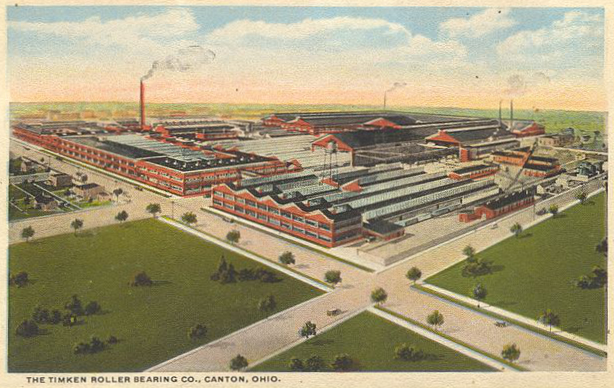"Your Father was born in Butcher's Race."
My grandmother told me that when I was very young.
Researching family history decades later, remembering the unusual place name, I searched online for a town named Butcher's Race. I knew it had to be in northern England, outside Durham. But I couldn't find it.
Eventually I realized that saying "I live in Butcher's Race" is, for a British person, the same as saying "I live on Butcher's Race" for an American. "Butcher's Race" was a street.
Robert Randolph Watkin was born on the third of September 1912 in a house on a street named Butcher's Race in the town of Tudhoe, Spennymoor close to Durham, England. His parents, Martha and William, were 22 and 23 years old. Robert was born ten days before their first wedding anniversary, and was named for his grandfathers, Robert William Watkin and Randolph Warburton. Because he was such a big baby his parents wanted to know how much he weighed. So they took him into town and asked the butcher to put their baby on the scale. He weighed more than ten pounds.
The history of the Durham area is deep. Norman Romanesque Durham Cathedral is seven miles north of Butcher's Race; construction started less than 30 years after the Norman conquest. Seven miles to the south are the remains of Roman Fort Binchester, built in 75 AD. Emperor Hadrian likely spent some time there during his visit to Britannia in 112 when he ordered that a wall be built - not far from Durham - across the island to protect Roman citizens from northern barbarians.
Robert was born into a community defined by and dependent on coal mining. People have been taking coal out of the ground around Durham since before the Roman conquest. Modern coal mining started in the mid nineteeth century and reached a peak in the early twentieth. In 1920 there were 187 coal mines in Durham county employing 170,600 men.
Robert's father was a coal miner, both of his grandfathers were coal miners, and all of his uncles were coal miners. The home he lived in, the school he attended, and the church his family worshiped in were all built by the coal mining company.
When Robert was a month old, his grandfather Randolph Warburton went to the United States. He arrived at New York City on October 18th on the Cunard liner Mauritania. The ship's passenger list includes his wife's name and their address in Pittington — the same address Robert's mother Martha gave on her marriage license. Randolph's final destination in the US was a coal mining community in Boone, Iowa; the mine workers union in Boone had 554 members in 1912, close to 10% of the population.
Randolph returned to England in March 1913, on the White Star ship Baltic (the same ship Robert and Martha would take back to the US after their visit to England in 1928). Why did he spend five and a half months away from home? Perhaps he hoped to find a new home for his grandson to grow up in, away from the social unrest and economic uncertainity of England's mining life? Or maybe he was visiting a friend or relative who was working in Boone.
The only image we have of Robert's life in the Durham mining community, where he lived until he was nine, is a photo taken when he was five or six years old. He is wearing a suit, tie, and cap, perhaps a school cap. His mother — clearly an expert seamstress — made the suit by taking apart one of her husband's suits and refashioning the material into a outfit for her son.
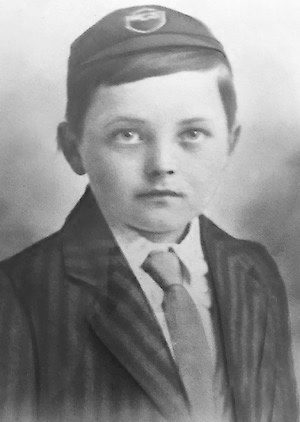
Robert at 5 or 6, in the suit his mother made
In the Fall of 1921, William, Martha, and Robert lived on Hamilton Row in the hamlet of Waterhouses, in a rural area near Durham. There was a Colliery (mine and associated buildings) in Waterhouses, and William was likely one of the 445 men working there. Hamilton Row runs for about a half mile between Russell Street and Ivesley Lane. The Black Horse Inn, built in 1820, stands at the Ivesley Lane end of Hamilton Row. Perhaps William stopped there for a pint on his way home from the mine; maybe the family went for an occasional meal. Still open today, The Black Horse Inn has cask ales on tap and serves lunch on Sundays.
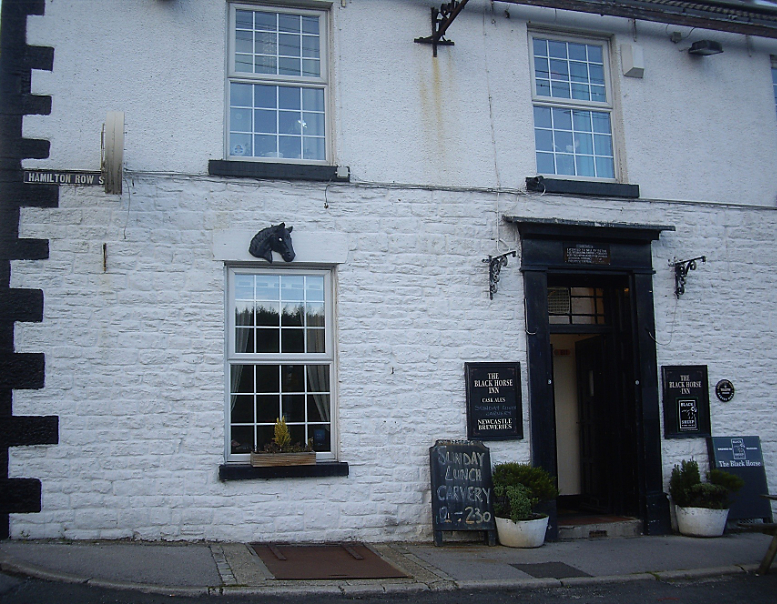
The Black Horse Inn on Hamilton Row
Three weeks after Robert's ninth birthday, William, Martha, and Robert left their home on Hamilton Row, took a train to Liverpool, and boarded the Cunard liner S. S. Carminia. Travelling on 3rd class tickets, they are listed as Miner, Housewife, and Scholar, aged 32, 30, and 9. After arriving in Halifax, Nova Scotia on October 4th, 1921, they travelled about 135 miles to the small town of Joggins Mines.
Joggins is at the northeastern end of the Bay of Fundy (which has the highest tides in the world) at the border between Nova Scotia and New Brunswick. As early as 1686 Acadians were mining coal in the area.
The fossils in the sea-side cliffs at Joggins are the world's most complete record of life on earth between 318 and 303 million years ago. To Sir Charles Lyell, the founder of modern geology, the cliffs at Joggins were what the Galapagos Islands were to Charles Darwin. In fact, Darwin mentions Lyell's discoveries at Joggins in "On The Origin of Species". The fossils at Joggins also featured in the debate - between Thomas Huxley and Bishop Wilberforce - on the theory of evolution, a debate held at Oxford in 1860, a few months after the publicaton of Darwin's book. The Joggins Fossil Cliffs were made a UNESCO World Heritage site in 2008.
Robert may have spent time walking along the beach near his home in Joggins, picking up fossil-filled rocks and skipping them out into the bay.
During their time in Canada, William likely continued to work as a coal miner. Perhaps their brief stay in Canada was necessary in order to earn, after paying for passage from England, enough money to pay for transportation through Canada and into the United States.
Robert was not amused when, one day at school in Joggins, a classmate, knowing Robert had recently arrived from Europe, turned to him and said, "boy, you sure learned to speak English fast!"
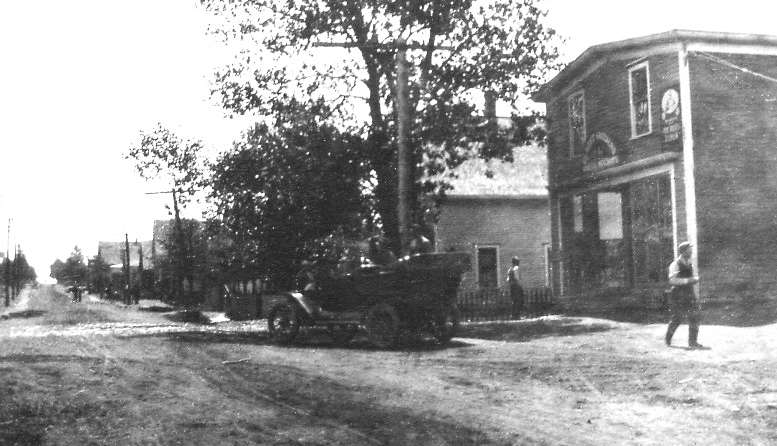
Joggins Mines main street, 1920
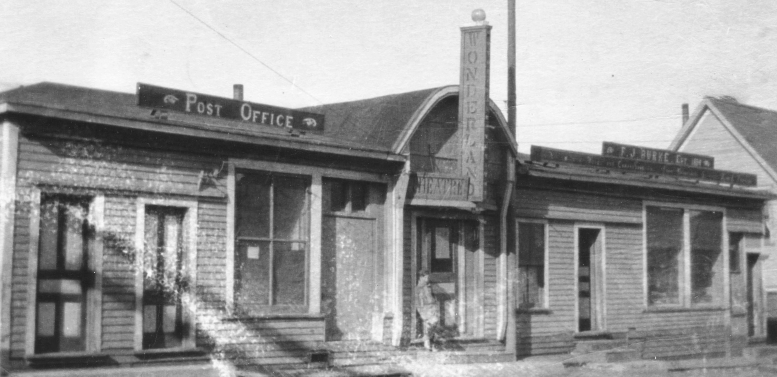
Downtown Joggins Mines in 1925: Post Office, Theater, and Store
Four months after arriving in Nova Scotia, the family travelled by train to Toronto, and then to Niagara Falls, where they crossed into the United States on February 15, 1922.
At the border an immigration official filled in arrival cards for Willam and Martha.
From Martha's card:
Watkin, Martha accompanied by: son Robert
Born: Croxdale, England; Age: 31
Race: English; Nationality: English
Last Permanent Address: Joggins Mines, NS
Ever In US: No; Passage Paid By: Husband
Money: $0 (William had $212, worth about $3,000 today)
5 foot, 2 inches; medium complexion, brown hair, blue eyes, no distinguishing marks
Seaport and date of landing and name of steamship: Halifax, October 4, 1921, S/S Carmania
Destination and name and address of relative or friend to join there:
Canton, Ohio, cousin Robert Wilkinson 2348 16th Street
Robert Wilkinson was born June 30, 1884 in Hedley Hope, Durham County, about eleven miles from Croxdale where Martha Warburton would be born seven years later. He was the youngest of four children. John James was three years older, Charles Edward eight years older, and Emily twelve years older. The family also had a daughter named Elizabeth, who died at age two eight years before Robert's birth.
Bob's father, William, a coal miner, was 35 when Bob was born, and his mother Elizabeth (maiden name Fenwick) was 31. Although Bob might have spent some time in the mines early in life, by age 16 he was working as a shopkeeper and grocer.
As a young man Bob Wilkinson played piano (and maybe violin) in a local band, and Martha Warburton attended dances where he performed.
Bob Wilkinson married Catherine Huxley in the Fall of 1905. Bob was 21, Catherine was 27. The reason that Bob Wilkinson is listed on the Watkin's arrival card as a cousin is that Catherine was Martha Warburton's cousin; Bob and Martha were cousins by marriage. Catherine's mother was Martha's aunt Hannah.
Catherine's father William was a pork butcher and grocer. As a teenager Bob Wilkinson worked for a grocer. Maybe that grocer was William Huxley, maybe Bob fell in love with his boss's daughter.
Bob and Catherine had one baby who did not survive infancy. On September 4, 1908, Catherine gave birth to twin sons: William Huxley Wilkinson and John Fenwick Wilkinson.
In November of 1908, when the twins were two months old, Bob sailed from Liverpool to Quebec, the first of five Atlantic crossings he would make in the next twelve years. He was on his way to join his brother in the coal mining town of Lafayette, Colorado. Sometime in 1909 Catherine and the twins came to the US. By the time the census was taken in the Spring of 1910 the family was living in Wilkeson, Washington, a coal mining community outside of Tacoma.
In October 1910 all four crossed the Atlantic back to England. Bob returned to North America early in 1911. Catherine and the boys stayed in England. She was living with her parents William and Hannah when the UK census was taken in April of 1911.
In February 1912 Catherine and the twins sailed to Halifax, Nova Scotia, and then travelled on to join Robert in Winnipeg, Manitoba, where they lived for the next two years.
In the Spring of 1914 the family left Winnipeg and entered the US via Minnesota on their way to Canton, Ohio. They were going to visit Minnie Wharton, Bob's niece. Minnie's mother was Bob's sister Emily. Minnie eventually moved from Canton to Winnipeg, where she died in 1927. Emily died in Winnipeg in 1933.
In 1915 the Wilkinson's daughter Hannah was born in Canton.
In 1920 the Wilkinson family, including five-year-old Hannah, visited the UK for for four months. They probably spent time with the Watkin family; their stories about life in the US may have influenced William and Martha's decision to leave England two years later.
When Bob Wilkinson left Canton with Martha Watkins in 1931 he was 46 years old and had been married to Catherine for twenty five years. Their sons were twenty two and their daughter was sixteen. Nine years later the 1940 census shows that twenty five year old Hannah is working as a stenographer in a law office and living with her mother. And that Catherine's marital status is "widow"; her husband is dead to her.

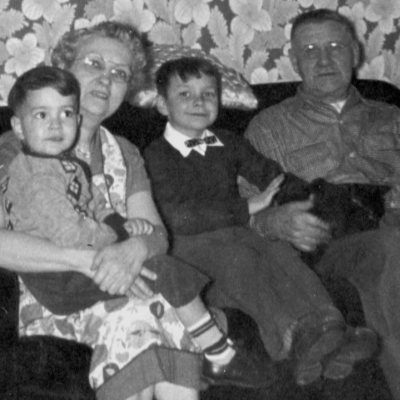
left: Bob Wilkinson, about 1949, with Delores, Martha & Bruce, in the apartment on Cleveland Drive.
right: Brian, Martha, Bruce & Bob, with BoBo the cat, at the Wilkinson's house on Reist St, mid 50's.
In the late 19th and early 20th century Canton, Ohio was a center of heavy industry. The Timken Roller Bearing Company moved their headquarters from St. Louis to Canton in 1901 in order to be close to auto manufacturers in Cleveland and Detroit as automobiles began to replace carriages. William Watkin worked at Timken for many years, and the company remains one of the largest employers in Canton today.
The six years in Robert's life from age 9 to 15 are a bit of a mystery. The only insight into his childhood in Canton comes from a few photographs of him - some with Martha, and some of him playing with his friends.

Robert at the front of the wagon, Martha standing by the door
And there is a single photo of Robert with his father, taken when Robert was about 14 years old.
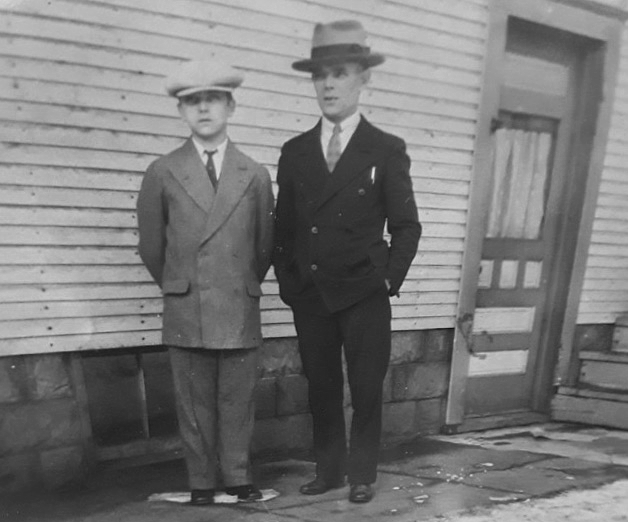
Robert and William. Probably outside their home. Maybe July 4th, 1927.
William became an American citizen in March of 1927, and since Robert was a minor, that automatically gave him American citizenship as well. Martha became a citizen in March of 1928.
The family story of how our last name was changed from Watkin to Watkins has always been that some immigration official mistakenly wrote the last name with an "s", and it was too much trouble to change it back. Looking at the naturalization documents proves that story wrong. When William and Martha became citizens, five and six years after entering the country, their last name was still Watkin.
In 1928, when Robert was 15, he and his mother went back to England for four months to visit Martha's parents. Robert kept a journal recording his impressions of the trip from Canton to Durham, and listing the places they visited as tourists in London. The text of his journal is at the end of this biography.
At the Canton YMCA Robert became an excellent swimmer, earning Red Cross lifesaving pins and a swimming medal, inscribed "Canton Champ '29." He also took piano lessons, learning to play Chopin beautifully.
The 1930 Census shows the family, now with an "s" at the end of their name, renting an apartment at 206 Dartmouth Ave, SW for $45 a month, and declaring that they do have a "radio set." William is 41, Martha 39, and Robert 17. William is working as a machinist at the Timkin Roller Bearing factory. They have a boarder living with them: William P. James, a 46 year old British citizen who arrived in the US in 1929, and is working as a carpenter for a building contractor. He may be Martha's relative; in 1911, a few months before marrying William, Martha was living with an aunt and uncle named James.
Robert graduated from McKinley High School in June of 1931. The McKinley High yearbook for 1931 does not list any participation in school clubs or sports by Robert, but does show him as a member of the National Honor Society.

Robert's High School Yearbook Photo
There were problems in William and Martha's marriage from the beginning. Years later she would tell her daughter-in-law stories of how William mistreated her. For example, when Martha was pregnant with Robert, William complained about her frequent trips to the bathroom at night. They disturbed his sleep. So the night before she gave birth, she was forced to sleep in a chair.
In 1928, when Martha and Robert visited England, her father tried to convince her to stay and make a new start. But she decided to return to Canton. Perhaps she had already begun to build her new life there.
William and Martha filled in immigration cards in when they arrived at Niagara Falls in 1922. One of the questions is "destination, and name and address of relative or friend to join there". Their answer was "Canton, Ohio; Cousin Robert Wilkinson, 2348 16th Street."
o o o
In 1931 Martha Watkins and Bob Wilkinson left their spouses to start a new life together. They moved to Western New York, where they had friends. On New Years Day, 1932, Robert's half brother Frank Wilkinson was born in Blasdell, NY.
Alone in the house with his father, Robert defended his mother. One day during a particularly heated argument, William told Robert to leave and go live with his mother. He did move out of his parent's home, but did not go to Blasdell. Maybe he did not know where Martha was living. Maybe he was still in school and needed to stay in Canton until graduation. Maybe he needed to earn money to pay for the trip to Western New York. Whatever the reason, he moved into a room in the Canton YMCA.
The Canton city directory published in March of 1932 shows Robert living in the YMCA, working as a clerk at the Eagle Drug Co. The Eagle Drug Company was a local chain in Canton. There were several stores in the city. The firm started out as the Eagle Drug Store, with two stores in 1922. By 1924, it was incorporated and operating three stores.

The Eagle Drug Store on Market Street in Canton
During the Spring of 1932 Robert moved from Canton to Western New York to be with his mother and Bob Wilkinson. They were living in Blasdell, 8 miles south of Buffalo. On April 1st Robert enlisted in the Army at Buffalo. He was 19 years old; his half brother Frank was three months old.
On April 29th Robert R. Watkins, Private First Class #6711840, boarded the troop transport ship Republic at Fort Slocum on David's Island in Long Island Sound. The Republic was headed for Honolulu, in the US territory of Hawaii, by way of the Panama Canal and San Francisco.
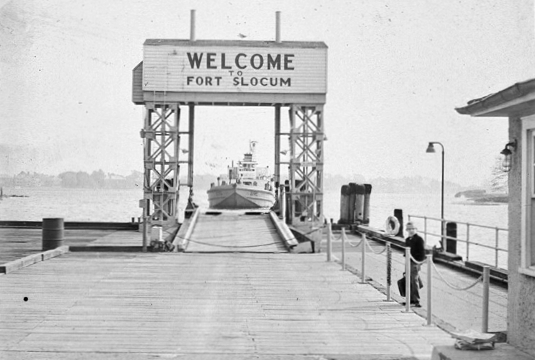
Fort Slocum, NY
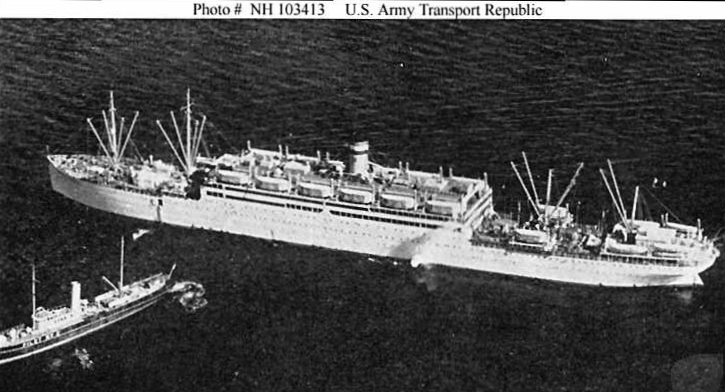
Troop Transport Ship Republic
Robert spent three years at Schofield Barracks on Oahu in Company E, 21st Infantry.
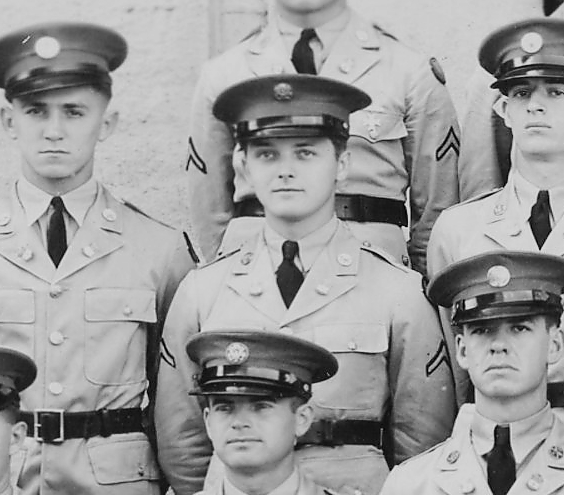
PFC Robert R. Watkins at Schofield Barracks, Hawaii

Schofield Barracks entrance gate in 1932
We don't have any record of how his time there was spent, although we do have the Christmas dinner menus for 1932 and 1933.
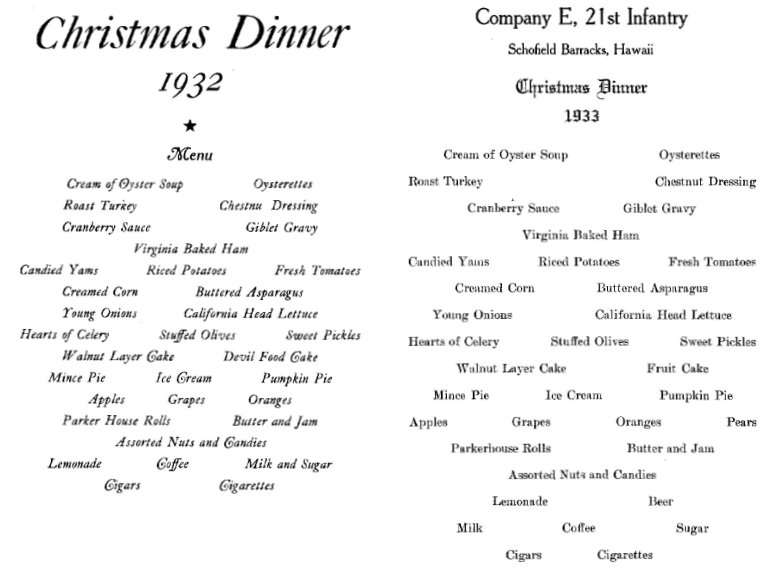
Pretty much the same dinner both years, although there was beer in 33
In June of 1933 Robert qualified as a rifle sharpshooter.
In October of 1933, when Robert had been in the Army a year and a half, the divorce between his parents became final. The paperwork says that Martha had been "served with summons and process by publication", and was "in default for answer", and had been "guilty of gross neglect of duty toward [William]". William did not have an address for Martha, so his lawyer published the summons in local newspapers. There was no reply, and the marriage was ended.
William Watkin married Beatrice Lina Buchanan [date?]. On October 9, 1934, when Robert was 22, Robert's half brother William Buchanan Watkin was born in Canton.
In December of 1934 Robert was promoted to Corporal. He was discharged from the Army on March 13, 1935 in Brooklyn, and received $88.81 in travel pay.
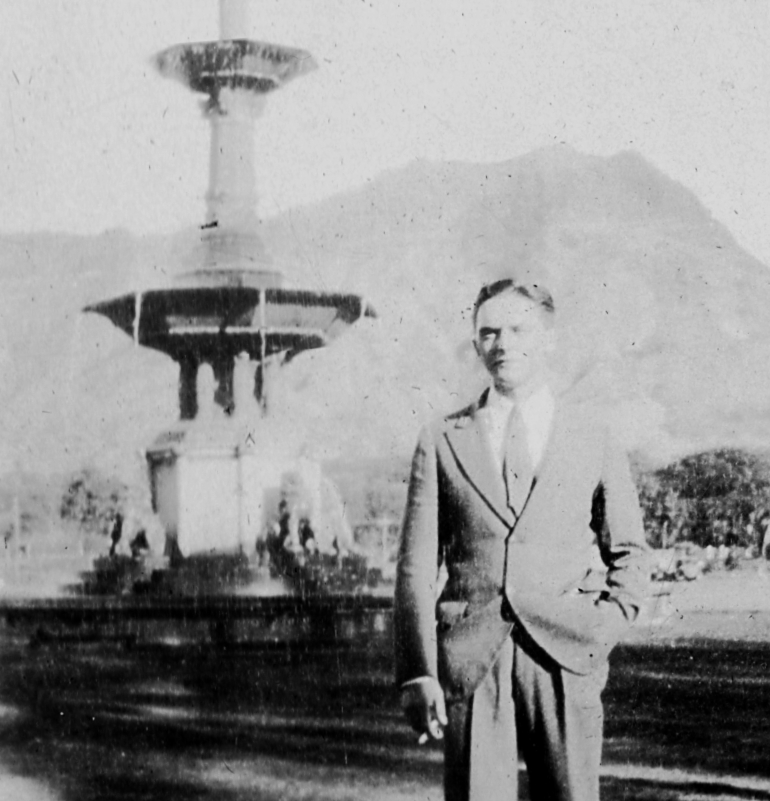
Robert in Honolulu, with Diamond Head in the background
Robert was out of the Army for just under a year and a half, probably living with Bob Wilkinson, Martha, and Frank on Mulberry Street in Buffalo. Jobs were hard to find during the depression, and on August 10, 1936, Robert re-enlisted in Buffalo for another three years.
Robert joined the 51st Signal Battalion, stationed at Fort Monmouth, New Jersey.
about the Signal Corps - about Ft Monmouth
Fort Monmouth was thirty miles from Lakehurst, New Jersey, where the German dirigible Hindenburg burst into flames on May 6, 1937 as it arrived with 97 people on board. Thirty six people died. The commandant of Lakehurst Naval Air Station called Ft. Monmouth for assistance that night. A convoy of 11 officers and 115 enlisted men left the Fort just after midnight and remained at Lakehurst until the afternoon of May 8th, doing guard duty and providing crowd control. Robert happened to be on leave on the sixth, otherwise he would have been one of the soldiers at the site of the disaster.
During the 1930s, the US Army used experience gained during the first World War to reorganize and streamline combat divisions. As part of this process, the 51st Signal Battalion participated in extended maneuvers and war games in Texas. A convoy of 55 vehicles carrying 13 officers and 350 enlisted men - including Robert - left Fort Monmouth on July 21, 1937. It was the longest motor convoy trip in US Army history to that point.
They arrived at Fort Sam Houston, outside of San Antonio, on August 2nd. There had been a stop in Memphis for oil changes and other vehicle maintenance, and the battalion recreation officer had arranged sight seeing tours for the men en route. Robert's photo album has pictures taken during some of these tours.
The war games included testing of portable radio units - walkie talkies - that had been developed at Fort Monmouth. The devices worked well in the simulated combat conditions, and were used extensively during World War II both in Europe and in the Pacific.
The exercises concluded on November 13th, and the battalion returned to New Jersey. Total round trip distance was 3,739 miles, passing through fourteen states and the District of Columbia.
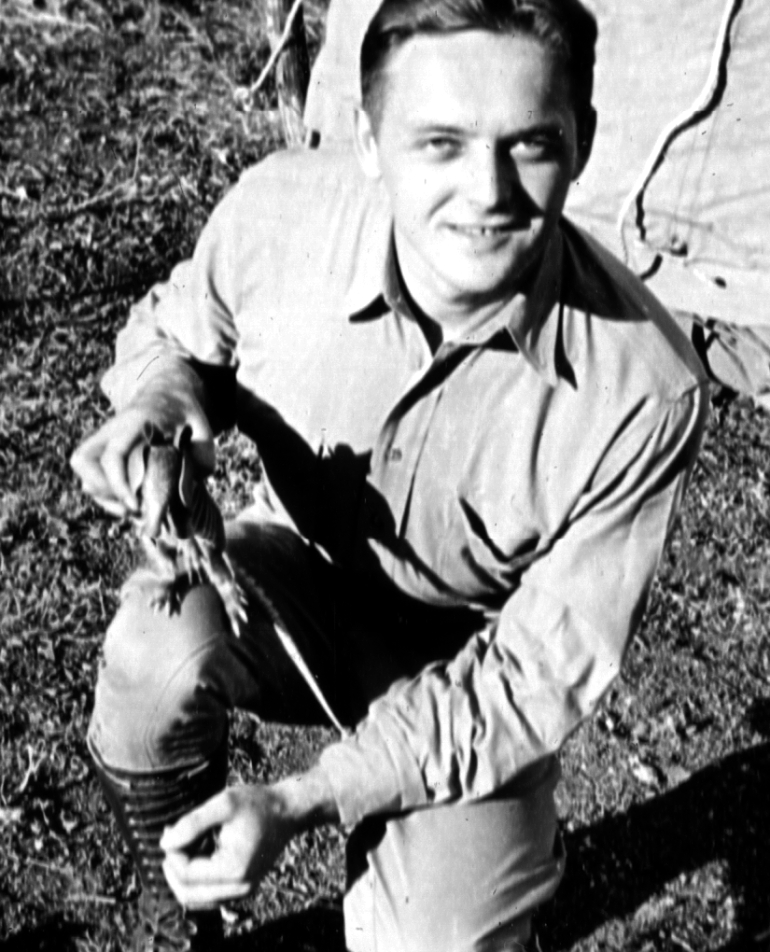
Robert holding an armadillo in Texas in 1937
On the 30th of November, 1937, Robert graduated from the Radio Communications Course at The Signal Corps School at Fort Monmouth. His course of study included: code practice, installation and adjustment of tactical radio and telegraph equipment, radio procedure for tactical nets, electricity and magnetism, basic shop work, and elements of radio.
Robert also studied at Monmouth Junior College for two semesters in 1939. He got straight A's in General Physics, Calculus, and Trigonometry.
Robert was discharged at Fort Monmouth on August 9, 1939. On his discharge papers, the entry for Qualification in arms includes PSD 7-7-37, which probably means Protective Services Detail. He received $200 in travel pay.
[from Dad's photo album: 51st signal battalion, aug 1937 arrival at Ft Sam Houston, Texas; war games in Texas: Sep, Oct 37; Memphis (chow line); natural bridge, VA; camping at New Market, VA; camping at York, PA; Bristol TN/VA; Andrew Jackson's estate near Nashville; Camp Bullis, TX; 51st signal battalion tents outside 15th Field Artillery barracks, TX; "doodle bugs"; San Antonio, TX; Rumsai(?) beach; Ft. Monmouth, NJ; Longbranch beach 1937; Seabright beach 1937; Gettysburg 1938; World's Fair 1939; ]
Back in Buffalo
text text text
On June 2, 1924, John and Mary Kirsch's fifth child, Delores, was born in their home on Englewood Avenue in Buffalo. Robert, 240 miles away in Canton, would turn 12 that September.
Delores, her parents, and her siblings — John, Thomas, Rita, and Paul — soon moved to a larger home on Royal Parkway in Williamsville. The final addition to the family arrived when Delores was six years old: her brother Lawrence (the family called him Sonny).
Delores and her brothers and sister attended school — elementary and high school — at the Newmann School associated with St. Peter and Paul church in Williamsville. During her sophmore year in high school, Delores missed several weeks of school due to illness. Faced with the probability that she would need to repeat the grade, and no longer be in the class of friends she had gone to school with since first grade, she decided to drop out of high school.
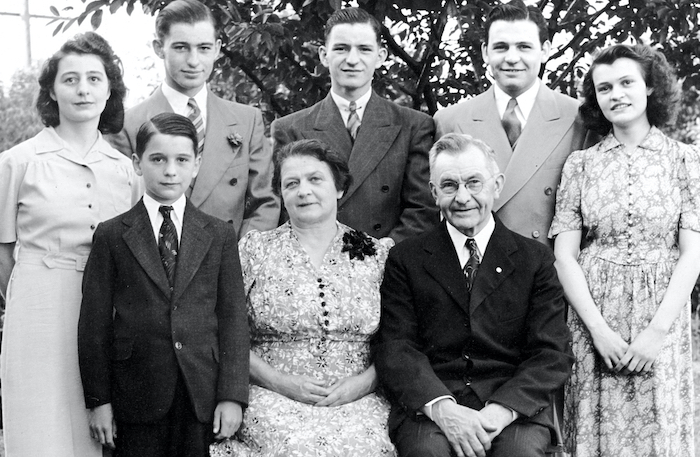
The Kirsch family, in their back yard in July 1941.
Rita, Paul, Thomas, John Jr, Delores;
Lawrence, Mary, John Sr
Delores got a full time job working in a confectionary store at the corner of Main and Cayuga streets in Williamsville, walking a mile to work in the morning, and back home to have lunch with her mother. In the summer of 1942, when she was 18, she also completed a Red Cross home nursing course.
But what she really wanted was to get a good paying full time job at the Curtiss-Wright airplane plant near the Buffalo airport, where her brother Paul was already working, and she got that job in the Fall of 1942.
The Curtiss-Wright company was formed in 1929 in Buffalo from the merger of Wright Aeronautical of Dayton, Ohio, and Curtiss Aeroplane of Buffalo. During World War II Curtiss-Wright employed 180,000 workers (about 40,000 at the Buffalo airport plant), and ranked second - behind General Motors - in the value of wartime production contracts. Among the planes built at the Buffalo plant was the P-40 fighter that was flown by the Air Forces of 28 countries during World War II. Nearly 14,000 P-40s were built - all in Buffalo - by the time production ended in 1944.
As a new employee, expecting to soon be working on the factory floor making fighter planes, Delores took the bus to attend new employee classes at the Curtiss-Wright training facility on High Street in Buffalo. It was an indication of how sheltered her life had been that the sight of a woman smoking a cigarette on the bus shocked her.
While at the training facility, a family friend who worked for Curtiss-Wright saw Delores and suggested that she would be happier working in the inspection department instead of on the production floor. So a few days later she reported to the airport plant, and to her new boss, the assistant supervisor of the Inspections Department, Robert Watkins.
Robert bought a new car sometime in late 1942 or early 1943, and asked Delores if she would like to go out with him. She asked if she rated a ride in the new car, and he wrote this reply:
What do you mean, do you rate the new car? Of course you do. Why do you think I waited until now to ask you out? As far as I'm concerned you rate the best.
I hope you make up your mind to go Thursday. I think we could have some good times together before I'm called to the Army. It's too bad about this pleasure driving ban, but we can get around if you really want to go.
Don't keep me in suspense too long. If you decide not to go I'll still look forward to seeing you every day.
Bob and Delores went on their first date on May 27, 1943. They saw a movie (Five Graves to Cario, starring Francot Tone and Anne Baxter, directed by Billy Wilder), and went to dinner.
To get from the parking lot into the plant, employees had to walk through a tunnel. Robert and Delores started meeting in the tunnel before and after their work day. At home in the evenings Robert wrote notes to Delores, handing them to her in the tunnel the next morning.
In a note to Delores in the Summer of 1943, Bob wrote:
If the driving ban is lifted before the summer is over, as I hope it will be, we can really go places. There are plenty of lovely spots in New York that I haven't seen and I'd rather see them with you than anyone else.
It looks now as if I'm going to be able to rent a cottage on Lime Lake for a week during my vacation. Maybe you could take a day off and I could come and get you and drive you down for the day.
I'm not writing you any more notes until I get one from you at least two pages long. If you don't know how much I care for you now you never will. It's hard to put down in words how I feel about you but I've done my best and I hope you understand.
Delores, and her brother Sonny, did join Bob and his family at their vacation cottage for three days.
After she left, Bob wrote her a letter:
I made good time back to the lake last night. I was back a little before ten o'clock. Mother was delighted with everything your mother sent down …
The raspberries were delicious. We've been having them with cream for dessert …
Mother said this morning she missed having you around. You know how I feel. A part of me left when you did, dear …
Those three days together made me realize how much I want you and need you …
My vacation might as well be over now too. I'm just waiting for Saturday when I'll be back and see you again …
I'm sure everything will work out for us in spite of the war …
we'll have to wait and see how I make out with my deferrment …
Tell your mother Sonny is getting along fine. Frank and him are having a swell time together …
he doesn't seem to be homesick at all …

At the Wilkinson's house on Mulberry St, Summer 1943
more here
Robert and Delores were married on Saturday, April 29th, 1944 at St. Peter and Paul church in Williamsville. Delores would turn 20 in June, and Robert would be 32 in September. Because Robert was not Catholic, they were married in the rectory instead of in the church, and Robert had to agree to raise their children as Catholics.
They went to Toronto for their honeymoon, staying at the Royal York Hotel.
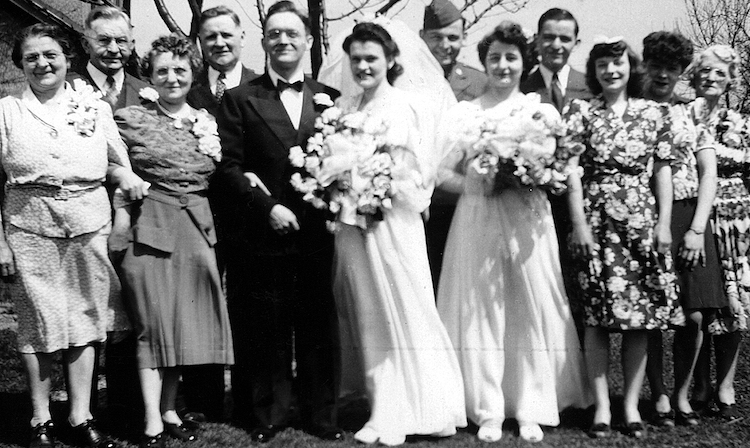
Robert and Delores's wedding day: April 29, 1944
This photo was taken in the back yard of the Kirsch home on Royal Parkway
Mary & John Kirsch, Martha & Bob Wilkinson, Robert & Delores, John, Rita, Thomas & Millie, Ethel, Mary's Sister Clara
about Kensington Village Apartments
In May of 1945, when Robert and Delores had been married for a year, Robert travelled to Madison, Wisconsin to take a two-week Army Air Force packaging course given at the US Forest Products lab.
He stayed at the Belmont Hotel, which is now on the National Register of Historic Places. Built in 1924 to accomodate business travellers, the 11 story building was constructed next to the State Capitol. As a result, legislation was passed to limit building heights in the city in order to protect views of the Capitol.
Robert wrote several letters to Delores while in Madison. Here's the beginning of the first, written the day after arriving in Madison.
about Western Electric
letters from Chicago
class at Cornell
text text text
The 1960's
text text text
A Visit To England
In May of 1928, when Robert was 15, he and his mother visited England. Robert kept a journal, recording his thoughts and experiences.
Left Canton Thursday night, May 17 on Manhattan Limited. Spent very comfortable night in Pullman. Arrived in New York at about eight thirty-five. We went to the hotel and left our baggage, then we went up 23rd St. to 5th Ave. and bought a raincoat for Mother at Hearn's. Found no trouble in finding our way around New York.
Saturday May 19th, Entrance to New York Harbor
The day is foggy and damp, there are fully eight boats waiting to get out to sea. The Cunard Liner, Samaria, just passed us on her way out. On the port side and a little to the rear there is a ship belonging to the Atlantic Transport line. We had our first meal on board at about 12:30. The food is excellent and the dining room is decorated beautifully. The Atlantic Transport liner must have been waiting to get into the harbor because it has raised its anchor and is heading in. It is the Minnewaska.
Sunday May 20th
Held up by fog most the day. Just after dinner it lifted, and there were at least forty ships around us. The Baltic passed us on her way to New York. After supper the fog settled down again, causing us to lose time. It is 1:00 o'clock when I am writing this, Monday. We should be a day out to sea, and we have not even made Boston yet, and it is doubtful whether we will make it today or not. A Cunard liner passed us today on her way in. I believe it was the Sycthia. We will make Liverpool Tuesday or Wednesday.
On Sunday night at about 10:00, we noticed a steamer to port and a little ahead surrounded by tugs. Later we learned it was the Penland, which had been rammed in the fog. We took some of her passengers on board at Boston. The Penland was bound for Antwerp.
On Tuesday we made pretty good time. We made Boston about 7:00 Mon. We went pretty good all through the night. Wednesday raining, heavy sea and head winds, rotten luck. A strong wind and head sea prevailed during the voyage. The sea being a little choppy one day.
On Tuesday morning May 29th we made Queenstown. It was a beautiful morning, the sun shone brilliantly, and the sea was as calm as a mill pond. We sighted land about 4:00 this morning, and skirted the coast all morning. The scene was a beautiful one, the ship gliding on the smooth water, her decks as firm as can be. Thousands of sea gulls, big white, innocent looking birds, surrounded the ship, and whenever the rubbish from the ship's kitchens came hurtling from the side of the great liner, they all made a dive for it, and there was much squealing and squawking about the bits of food among it.
The Irish coast looked beautiful. Green fields hemmed in by trimmed green hedges, with here and there a newly ploughed field, and dotted with picturesque cottages. The great liner plowed her way majestically into this beautiful harbor, on such an ideal morning impressed me as having much the appearance of the conqueror entering the fallen city.
We did not go entirely into the harbor, but when we got to the entrance reversed the screws and made a complete turn heading her nose out to sea again. Then the business of disembarking began. A tender, flying the White Star banner, came along side and was made fast by ropes. A chute connected the liner and tender - down which the luggage was sent to the smaller boat, and down which also the numerous bags of mail were sent.
Two Irish women came on board selling beautiful shawls and men selling walking sticks. The whole scene was now changed, the very air tinged with excitement. The faces of those returning to their native land - and to their loved ones - the picture of happiness, on the other hand those to whom all these scenes were new expressing wonderment and expectation tinged with excitement. Customs officers came on board to examine the passengers' papers. People seemed to be here, there, and everywhere, saying good-bye to new friends made on board, who would soon be forgotten in the excitement of new scenes and new faces. The last minute good-byes had been said, the tender was crowded with passengers, and its after decks piled high with luggage and mail. With one long piercing shriek of her whistle the tender shoved off amid the cheering of her passengers and the ones left on the steamer.
We looked perhaps for the last time on the faces of newly made friends, which might haunt us in days to come when we sat thinking over our experiences. The great engines down in the bowels of this great creation of man were started, and we headed out for sea. The dinner gong went just then and the remaining passengers retired to the dining room to their last lunch on board. After lunch the passengers that were left walked aimlessly around the deck, anxious to reach their destination and have the business of landing and passing the customs over with. The customs man stayed on board and stamped the landing card.
After supper, a thing which greatly surprised me was that it was as light as day at 10:00 o'clock at night. About twelve o'clock I came up on deck just in time to see a small point of land capped by a lighthouse and which I was informed was a part of the coast of Wales. I went below and went to bed, but was up on deck again at about 5:30. We were standing still - and it was a little foggy, and a chilly wind was blowing. As I was watching the water lap lazily the side of the ship, I saw a small row boat put off from a small sail boat on which was written in large letters "Liverpool Pilot". The row boat came along side and a rope ladder was thrown to the pilot. As soon as he was on board the engines were started and we moved forward.
The fog lifted and we soon came in sight of Liverpool which did not present the appearance of Queenstown harbor. The shore line being disfigured by wharfs and landing stages, and the water constantly churned to foam by ferry boats. Boats of every description were leaving landing stages or approaching them. Two tugs nosed her into the landing stage appearing like two small water insects dodging around some great sea monster. The dock was crowded with men waiting to unload the luggage. We had no sooner touched the landing stage than a covered gangway connected the ship and the dock.
We did not expect anyone to meet us but we were pleasurably surprised when we saw my grandfather standing on the dock. We watched the unloading of the luggage and identified our trunk. We were then allowed to leave the steamer. We passed the customs without any trouble. We had our trunk transferred to Lime St. station and rode to the station in a horse-cab. We left Liverpool at 11:00 o'clock, had a fine journey, changing at Leeds & York, and arriving in Durham at 4:45.
I must say that I don't care for the English trains with their small compartments, where you sit facing each other. The engines and trains appear like toys in comparison to our monstrous engines and Pullmans. But for all their smallness I believe they have got our trains beat for speed. The freight cars are worse than the carriages, I believe you could get four of them into an American box car easily.
From Durham we went to Sherburn by bus where we were the object of many curious glances. You would have thought, by the stares we received, that we some new species of animals arriving at the zoo.
June 30th: Durham Cathedral
August 14th: Usham College
Usham College is for the training of Catholic priests. They are sent from all over the world to it. Inside it appears much like a church, having many statues and paintings of the saints. In one room is a statue of St. Peter, and the big toe and part of the foot are worn away by the people kissing it.
August 21st
Travelled from Durham to London by bus. A distance of about 250 miles. Left about 8:00 and arrived at Kings Cross at 8:20 at night. Were met by our friends Mr. and Mrs. Morfitt, and went to Maison Lyons for supper. Then travelled by tube to their home in Kenton, a suburb of London.
August 23rd
Went from Kenton to Trafalgar Square by tube and saw the statue of Nelson. We walked up a wide and very pleasant avenue, with St. James park on the left, to Buckingham Palace. The entrance to this palace is beautified by the Victoria Monument, dedicated to Queen Victoria. It is a very beautiful and elaborate statue, done in white marble. The entrance is guarded by soldiers in elaborate red and blue uniforms with enormous - on their heads.
St. James Palace in Whitehall is the residence of the Prince of Wales. It has the reputation of being the second worst house in London. No. 10 Downing St., the residence of the Prime Minister of England, being the worst. The entrance to St. James Palace is guarded on each side of the gate by a mounted soldier belonging to a regiment known as the Royal Horse Guards-Blue. The equipment of one of these soldiers, when he is fully dressed is said to cost 145 pounds or $750. Just across the street from St. James is the home where the scaffold for the execution of Charles was erected.
Side Trips
Aug 21st: Came from Durham to London
Aug 23rd: Visited Westminster H. P.
Aug 27th: Zoo & Tussand's
Aug 28th: Went to Harrow
Aug 29th: Saint Pauls & Drury Lane Theatre
Aug 30th: Tower of London
Places in Durham
Durham Cathedral
Durham Castle
Places Visited in London
- Westminister
- Buckingham Palace
- St. James Palace
- The Zoo
- Madame Tussand's
- Houses of Parliment
- Tower of London
- The Cenotaph
- Trafalgar Square
- Oxford Circus
- Regents Park
- No. 10 Downing Street (Prime Min. Residence)
- Lord Kitchnerer's Residence
- Changing of Horse Guards at St. James
- St. Paul's Cathedral
- Regent's St. (one of the shopping centers)
- Harrow-on-Hill (Bryon's tomb, Harrow schools)
- Theatre Royal, Drury Lane
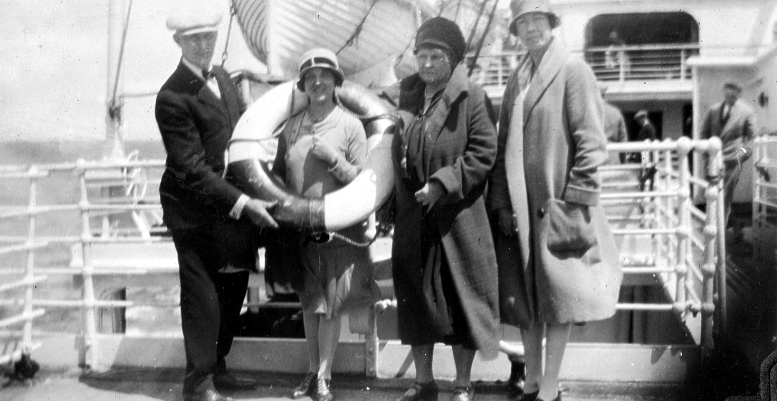
Martha, second from left, on the S. S. Celtic travelling from New York to Liverpool
[Some notes on the travel journal: Hearn's Department Store in NYC, photos of the ships?, page images from the journal, info on Queenstown/Cobh, why to Sherburn?, canned peaches and bread, Mr and Mrs Morfitt, Maison Lyons.]
-
Info from 1911 and 1901 census: men all coal miners, # people in 4 room house
-
Insert somewhere: Martha's bible award, sister that did not live
-
About emigration, unknown reasons (what about being just after WWI?, also miner's strike); was plan to make a life
-
in Canada, or was that always meant to be a stopover on the way to the final destination in Ohio?
-
School in Canton, photos in Canton, grade school certificate, high school yearbook, swimming medal and red cross life saving pins
-
Report cards from Monmoth Jr College
-
Living in Buffalo with Martha, Bob, and Frank
-
Marriage, could not be in church, promise to raise children Catholic
-
Living in apartment on Cleveland Drive
-
My birth
-
Graduation from UB
-
Trip to Canton
- rats in the attic
-
Brian's birth
-
Job at Western Electric
-
Move to Bennington, building the garage, painting the garage, finished basement, poker nights with Galinos
-
Family vacations, Robert's business trips
-
Move to Wickham
-
Beginnings of dementia
-
Hospitalization and passing






